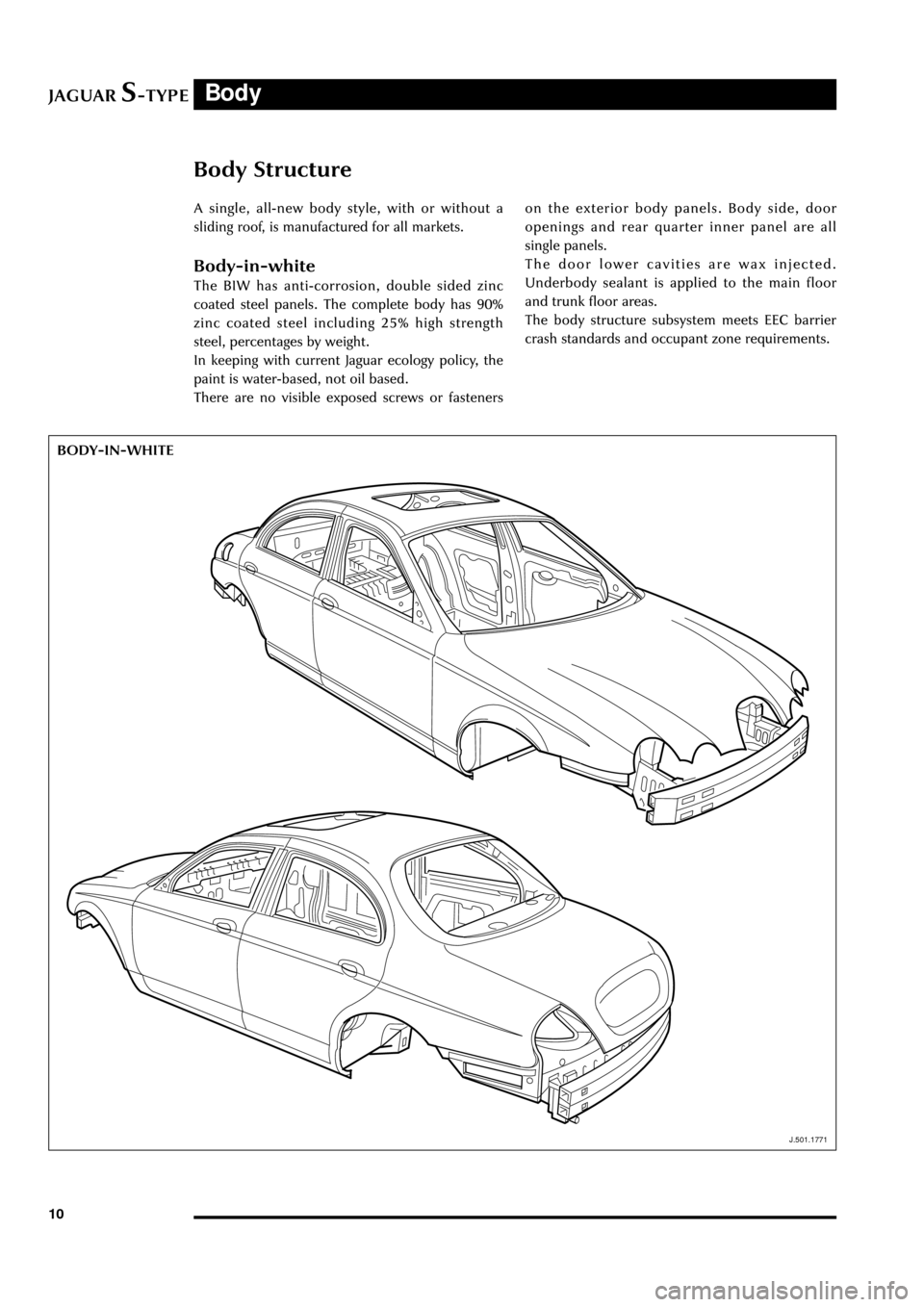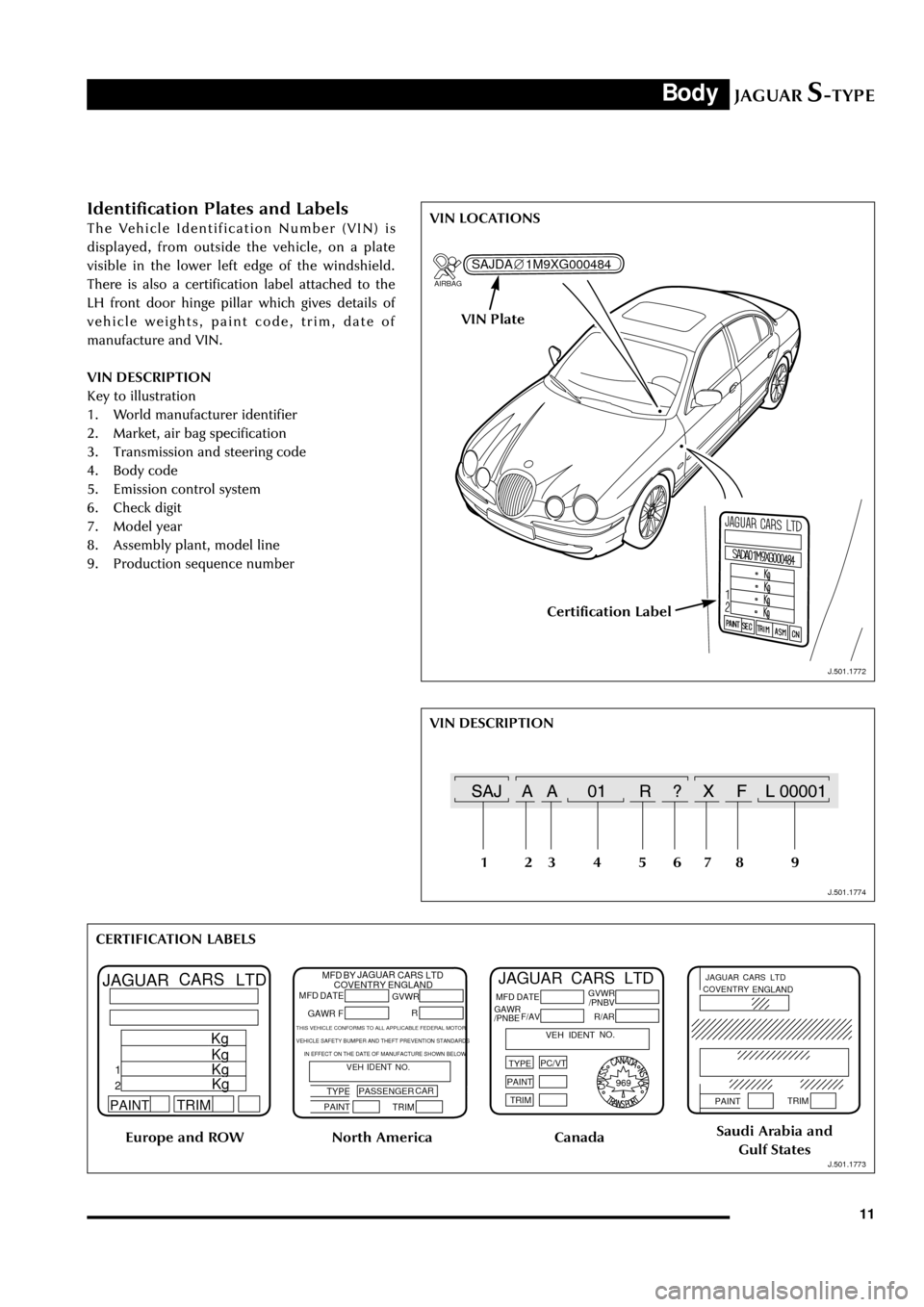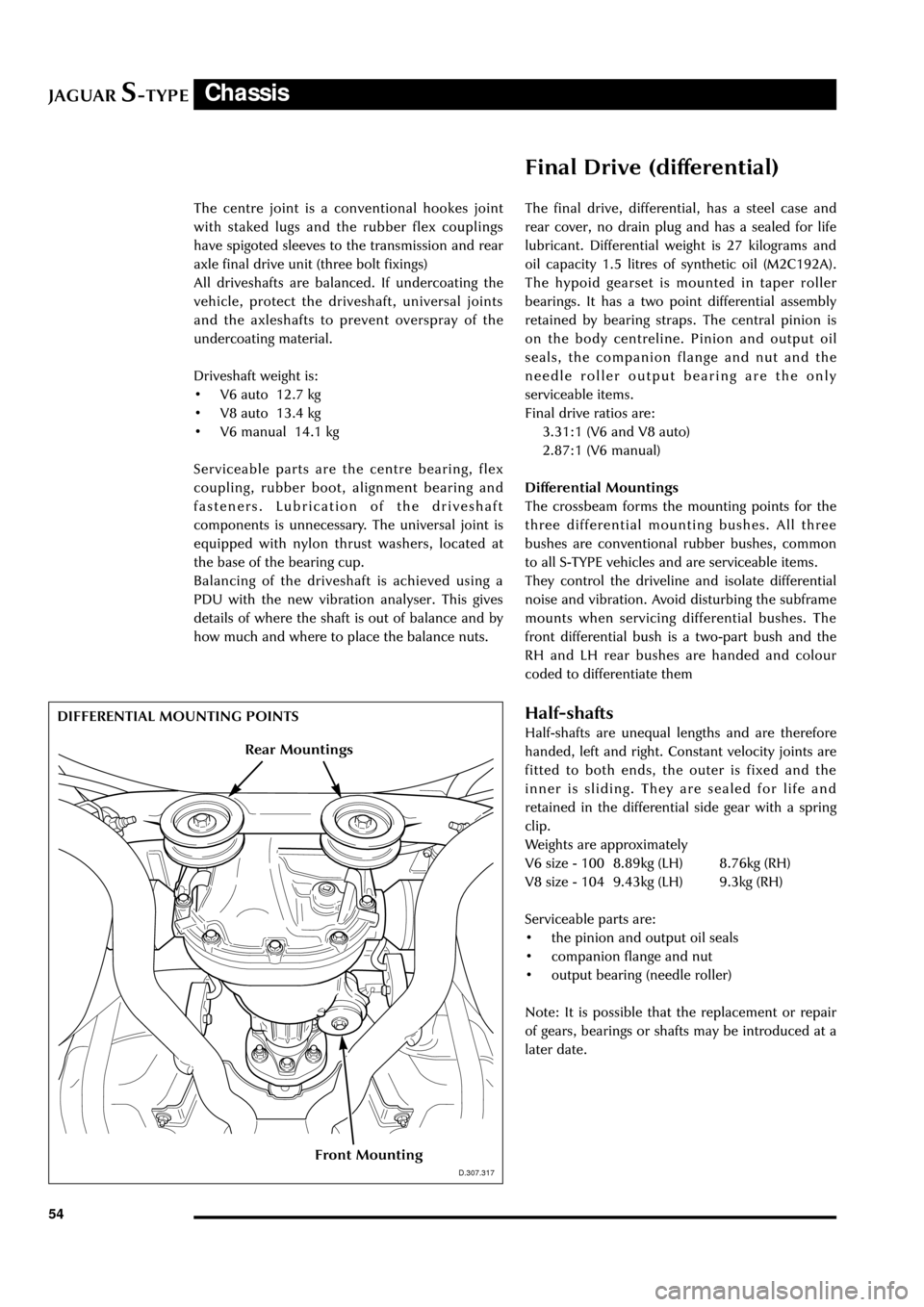weight JAGUAR S TYPE 2005 1.G Technical Guide Update
[x] Cancel search | Manufacturer: JAGUAR, Model Year: 2005, Model line: S TYPE, Model: JAGUAR S TYPE 2005 1.GPages: 133, PDF Size: 3.48 MB
Page 6 of 133

Contents
1
Subject Page
Glossary
Abbreviations 3
Introduction4
Vehicle Weights 5
Dimensions 5
Vehicle Features 6
Body
Body Structure 10
Engine Compartment 15
Trunk 16
Jacking and Towing 18
Glazing 19
Doors and Door Mirrors 21
Windshield Wipers and Washers 23
Exterior and Interior Trim 24
Seats 26
Interior Features 30
Occupant Protection
Seat Belts 32
Airbags 33
SRS Operation 35
Fuel System
Introduction 38
Evaporative Emissions System 42
Exhaust System
Introduction 44
Transmission
Introduction 45
Chassis
Introduction 46
Front Suspension 47
Rear Suspension 49
Wheels and Tyres 52
Driveline 53
Final Drive (differential) 54
Brakes 55
Power Assisted Steering 58
Steering Column 59
Climate Control
System Overview 63
continued:
JAGUARS-TYPE
Page 10 of 133

JAGUARS-TYPEIntroduction
5
Vehicle Weights
Vehicles with Vehicles with
3.0 litre V6 engines 4.0 litre V8 engines
Kgs (lbs) Kgs (lbs)
Kerb weight1635 (3604) 1725 (3803)
Front axle kerb weight 850 (1874) 915 (2017)
Rear axle kerb weight 785 (1730) 810 (1786)
Unladen weight 1705 (3759) 1795 (3957)
Gross vehicle weight2175 (4795) 2195 (4839)
Gross front axle 998 (2200) 1018 (2244)
Gross rear axle 1177 (2595) 1177 (2595)
Gross combination weight 4025 (8873) 4045 (8918)
D.501.1476
EXTERNAL DIMENSIONS
2909 (114.5)
*Height, with Comfort suspension 1401 (55.2) with Sports suspension 1411 (55.5)
Turning circle curb to curb 11.40 m (37 ft 9 in)
D.501.1476
Dimensions
4861 (191.4)
1819 (71.6)
1544 (60.78)
2040 (80.3)
1537 (60.51)
*
All dimensions in mm (in)
Page 15 of 133

JAGUARS-TYPEBody
10
Body Structure
J.501.1771
BODY-IN-WHITE
A single, all-new body style, with or without a
sliding roof, is manufactured for all markets.
Body-in-white
The BIW has anti-corrosion, double sided zinc
coated steel panels. The complete body has 90%
zinc coated steel including 25% high strength
steel, percentages by weight.
In keeping with current Jaguar ecology policy, the
paint is water-based, not oil based.
There are no visible exposed screws or fastenerson the exterior body panels. Body side, door
openings and rear quarter inner panel are all
single panels.
The door lower cavities are wax injected.
Underbody sealant is applied to the main floor
and trunk floor areas.
The body structure subsystem meets EEC barrier
crash standards and occupant zone requirements.
J.501.1771
Page 16 of 133

JAGUARS-TYPEBody
11
J.501.1772
AIRBAG
SAJDA1M9XG000484
Identification Plates and Labels
The Vehicle Identification Number (VIN) is
displayed, from outside the vehicle, on a plate
visible in the lower left edge of the windshield.
There is also a certification label attached to the
LH front door hinge pillar which gives details of
vehicle weights, paint code, trim, date of
manufacture and VIN.
VIN DESCRIPTION
Key to illustration
1. World manufacturer identifier
2. Market, air bag specification
3. Transmission and steering code
4. Body code
5. Emission control system
6. Check digit
7. Model year
8. Assembly plant, model line
9. Production sequence numberVIN LOCATIONS
J.501.1772
JAGUARCARSLTD
PAINTTRIM
12
Kg
KgKgKg
J.501.1773
JAGUARCARSLTDMFDBY
PASSENGERCAR
MFDDATE
GAWR F
GVWR
R
VEHIDENTNO.
TYPEPAINTTRIM
THIS VEHICLE CONFORMS TO ALL APPLICABLE FEDERAL MOTORVEHICLE SAFETY BUMPER AND THEFT PREVENTION STANDARDSIN EFFECT ON THE DATE OF MANUFACTURE SHOWN BELOW
ENGLANDCOVENTRY
TYPE
JAGUARCARSLTD
MFDDATEGAWR/PNBEF/AV
GVWR/PNBVR/AR
VEHIDENTNO.
PC/VT
PAINT
TRIM
969
TRIMPAINT
JAGUARCARSLTDCOVENTRYENGLAND
J.501.1774
VIN DESCRIPTION
CERTIFICATION LABELS
Europe and ROWNorth AmericaCanadaSaudi Arabia and
Gulf States
J.501.1773 J.501.1774
VIN Plate
Certification Label
198765432
Page 59 of 133

JAGUARS-TYPEChassis
54The centre joint is a conventional hookes joint
with staked lugs and the rubber flex couplings
have spigoted sleeves to the transmission and rear
axle final drive unit (three bolt fixings)
All driveshafts are balanced. If undercoating the
vehicle, protect the driveshaft, universal joints
and the axleshafts to prevent overspray of the
undercoating material.
Driveshaft weight is:
¥ V6 auto 12.7 kg
¥ V8 auto 13.4 kg
¥ V6 manual 14.1 kg
Serviceable parts are the centre bearing, flex
coupling, rubber boot, alignment bearing and
fasteners. Lubrication of the driveshaft
components is unnecessary. The universal joint is
equipped with nylon thrust washers, located at
the base of the bearing cup.
Balancing of the driveshaft is achieved using a
PDU with the new vibration analyser. This gives
details of where the shaft is out of balance and by
how much and where to place the balance nuts.
Final Drive (differential)
The final drive, differential, has a steel case and
rear cover, no drain plug and has a sealed for life
lubricant. Differential weight is 27 kilograms and
oil capacity 1.5 litres of synthetic oil (M2C192A).
The hypoid gearset is mounted in taper roller
bearings. It has a two point differential assembly
retained by bearing straps. The central pinion is
on the body centreline. Pinion and output oil
seals, the companion flange and nut and the
needle roller output bearing are the only
serviceable items.
Final drive ratios are:
3.31:1 (V6 and V8 auto)
2.87:1 (V6 manual)
Differential Mountings
The crossbeam forms the mounting points for the
three differential mounting bushes. All three
bushes are conventional rubber bushes, common
to all S-TYPE vehicles and are serviceable items.
They control the driveline and isolate differential
noise and vibration. Avoid disturbing the subframe
mounts when servicing differential bushes. The
front differential bush is a two-part bush and the
RH and LH rear bushes are handed and colour
coded to differentiate them
Half-shafts
Half-shafts are unequal lengths and are therefore
handed, left and right. Constant velocity joints are
fitted to both ends, the outer is fixed and the
inner is sliding. They are sealed for life and
retained in the differential side gear with a spring
clip.
Weights are approximately
V6 size - 100 8.89kg (LH) 8.76kg (RH)
V8 size - 104 9.43kg (LH) 9.3kg (RH)
Serviceable parts are:
¥ the pinion and output oil seals
¥ companion flange and nut
¥ output bearing (needle roller)
Note: It is possible that the replacement or repair
of gears, bearings or shafts may be introduced at a
later date.
D.307.317
DIFFERENTIAL MOUNTING POINTS
D.307.317
Front Mounting
Rear Mountings
Page 72 of 133

JAGUARS-TYPEClimate Control
67 Pipework
The suction hose and liquid line are a one-piece
assembly. A single screw connects them to the air
conditioning unit manifold at the bulkhead. A
further screw fixing and push-in clip secures them
at the side of the engine bay. The liquid line fixed
to the cooling module then joins with a block
fitting and the suction hose connects with a quick
connect fitting and routes across the underneath
of the cooling module to the compressor. The
compressor suction and discharge hoses are also a
one piece assembly.
A pressure transducer is fitted to the discharge
hose as it connects to the rear of the condenser.
The high side charge port is situated on the
manifold connecting to the receiver drier whilst
the low side is adjacent to the compressor behind
the LH front wheel.
The compressor is a 9Occ scroll, which is variable
from 100% to 30%. Compressor is standard
specification to all vehicles although package
makes them unique to V6 and V8.
Air Distribution
Air distribution is as follows:
¥ Defrost duct integral with the fascia.
¥ Face vents, plenum, manifold, centre face
duct, side face duct, side window demist duct
are all sub-assembled into the fascia.
¥ Driver and front seat passenger foot ducts are
installed in the fascia after it has been fitted
to the vehicle.
¥ Rear foot ducts are fitted to the underframe.
¥ Rear face duct fitted to transmission tunnel.
¥ Rear face vent fitted to console.
¥ Extractor boxes fitted in rear quarter panels.
All flaps are electric servo controlled and
comprise:
¥ Fresh/recirculation - heater/evaporator unit.
¥ Cold air bypass - heater/evaporator unit.
¥ Foot flap - mounted on plenum.
¥ Defrost flap - mounted on plenum.
¥ Face flap - mounted on plenum.
Sensors, for operation of the system, are:
¥ Ambient temperature sensor - located behind
the lower front grille.
¥ Solar sensor - fitted to the top centre of the
fascia at the defrost grille
¥ In-car sensor - aspirated from the plenum
venturi sensor mounted inboard of the
steering column.¥ Two heater air outlet sensors
¥ One evaporator air outlet sensor
Servicing
Routine servicing consists of particle filter
replacement.
Replaceable items on the climate control system
are:
¥ Servo complete with linkages
¥ Sensors
¥ Evaporator and seals
¥ Heater core and seals
¥ Blower motor
¥ Impeller/blower motor wheel
¥ Hoses
¥ Registers/vents
¥ Ducts, except the defrost
¥ Defrost and side window demist grilles
¥ Control unit
¥ Compressor
¥ Water pump
¥ Water valve
¥ Receiver/drier
¥ Condenser
There are no panel diagnostics but PDU facility is
available with extensive capability, similar to
current XJ and XK Series.
System refrigerant is R134a. Vehicle charge weight
is 800 gms and charging is through the high side
charge port only.
Oil type is WSH-MIC231-B and refill quantity is
180 cc -220 cc.
Special tools are hose clamp pliers and air-
conditioning hoses spring lock de-coupler.
General information
Ensure that the grille at the base of the windshield
is kept clear of leaves, snow or other obstructions.
A solar sensor is mounted on top of the fascia, in
the centre of the defrost grille, and this should not
be covered.
The air conditioning system should be run briefly
at least once each week with a cold setting to
prevent the seals from drying out with subsequent
refrigerant leaks.
When the engine and vehicle interior are cold the
fan speed may be low until the engine has warmed
up, this avoids excessively cold air being blown
into the cabin.